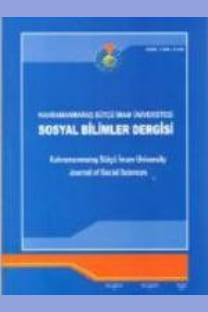Unorthodox monetary poliy of Turkey after the global financial crisis
Küresel finansal kriz ertesinde gelişmiş ülkeler ciddi zorluklar yaşadılar ve aşırı parasal genişleme stratejisini kullandılar. Ayrışma bağlamında, gelişmekte olan ülkeler artan sermaye hareketleri sayesinde yüksek büyüme oranlarına ulaştılar. Bu yeni dönemde, fiyat istikrarı ve enflasyon hedeflemesi rejimini finansal istikrara duyarlı yeni bir para politikası ile ikame etme çabası görüldü. Türkiyede de merkez bankası ortodoks olmayan bir para politikasına yöneldi. Yeni para politikası faiz oranı koridoru ve rezerv opsiyon mekanizması gibi yeni araçları içermektedir. Bu çalışma finansal istikrarı dikkate alarak makroekonomik istikrarı korumayı amaçlayan ortodoks olmayan para politikasını ele almaktadır.
Küresel finansal kriz sonrası Türkiye de ortadoks olmayan para politikası
Abstract: Developed countries experienced serious difficulties after the global financial crisis and used an excessive monetary easing strategy. Due to the decoupling, developing countries recorded high growth rates through raising capital inflows. In this new era, there is an effort to replace the price stability and the inflation targeting regime with a new monetary policy sensitive to financial stability. Also the central bank headed an unorthodox monetary policy in Turkey. The new monetary policy includes new tools such as interest rate corridor and reserve options mechanism. This paper examines this unorthodox monetary policy aiming to sustain macroeconomic stability taking into account the financial stability.
___
- Agénor, P. R.; Alper, K.; da Silva, L. P. (2012). Capital Regulation, Monetary Policy and Financial Stability, Central Bank of the Republic of Turkey Working Paper, no. 12/28, Ankara.
- Akçay, C.; Ocakverdi, E. (2012). An Interim Assessment of the Ongoing Turkish Monetary and Macroprudential Experiment, İktisat İşletme ve Finans, 27 (315), 77-92.
- Akçelik, Y.; Çörtük, O.; Turhan, İ. M. (2012). Mitigating Turkey's Trilemma Tradeoffs, Central Bank of the Republic of Turkey Working Paper, no. 12/29, Ankara.
- Akkaya, Y; Gürkaynak, R. S. (2012). Cari Açık, Bütçe Dengesi, Finansal İstikrar ve Para Politikası: Heyecanlı Bir Dönemin İzi, İktisat İşletme ve Finans, 27 (315), 93-119.
- Başçı, E.; Kara, H. (2011). Finansal İstikrar ve Para Politikası, Türkiye Cumhuriyet Merkez Bankası Çalışma Tebliği, no. 11/08, Ankara.
- Başçı, E (2012). Monetary Policy of Central Bank of the Republic of Turkey after Global Financial Crisis, Insight Turkey, 14 (2), 23-26.
- Borio, C.; Disyatat, P. (2009). Unconventional Monetary Policies: An Appraisal, Bank of International Settlements Working Papers, no. 292, Basel.
- Central Bank of the Republic of Turkey, (2012a). Financial Stability Report, vol. 15, Ankara.
- Central Bank of the Republic of Turkey, (2012b). Monetary and Exchange Rate Policy for 2013, Ankara.
- Coi, W. G. (2012). Macro-Prudential Policies in Korea, presentation in the Conference on Reserve Requirements & Other Macroprudential Policies: Experiences in Emerging Economies, October 8-9, Istanbul.
- European Central Bank, Statistical Data Warehouse, sdw.ecb.europa.eu Federal Reserve Bank of St. Louis, Federal Reserve Economic Data, research.stlouisfed.org
- Ganioğlu, A. (2012). Finansal Krizlerin Belirleyicileri Olarak Hızlı Kredi Genişlemeleri ve Cari İşlemler Açığı, Türkiye Cumhuriyet Merkez Bankası Çalışma Tebliği, no. 12/31, Ankara.
- Gallo, F. L. (2012). Latin American Experience with the Use of Macroprudential Policies, presentation in the Conference on Reserve Requirements & Other Macroprudential Policies: Experiences in Emerging Economies, October 8-9, Istanbul.
- Kara, H. (2012). Küresel Kriz Sonrası Para Politikası, Türkiye Cumhuriyet Merkez Bankası Çalışma Tebliği, no. 12/17, Ankara.
- Koray A.; Kara, H.; Yörükoğlu, M. (2012). Reserve Options Mechanism, CBT Research Notes in Economics, no. 2012-28, Ankara.
- Küçüksaraç, D.; Özel, Ö. (2012). Reserve Options Mechanism and Computation of Reserve Options Coefficients, CBT Research Notes in Economics, no. 2012-33, Ankara.
- Mimir, Y.; Sunel, E.; Taşkın, T. (2012). Required Reserves as a Credit Policy Tool, Central Bank of the Republic of Turkey Working Paper, no. 12/24, Ankara.
- Minsky, H. P. (1992) The Financial Instability Hypothesis, The Jerome Levy Economic Institute of Bard College Working Paper, no. 74, New York.
- Moreno, R. (2012). Dealing with Financial Stability Risks: Macroprudential and Other Tools, presentation in the Conference on Reserve Requirements & Other Macroprudential Policies: Experiences in Emerging Economies, October 8-9, Istanbul.
- NDiaye, P. (2012). Countercyclical Macro Prudential Policies in a Supporting Role to Monetary Policy, presentation in the Conference on Reserve Requirements & Other Macroprudential Policies: Experiences in Emerging Economies, October 8-9, Istanbul.
- Oduncu, A; Akçelik, Y.; Ermişoğlu, E. (2013). Reserve Options Mechanism and FX Volatility, Central Bank of the Republic of Turkey Working Paper, no. 13/03, Ankara.
- Svensson, L. E. O. (2011). Monetary Policy after the Crisis, prepared for the Conference Asias Role in the Post-Crisis Global Economy, November 28-30, San Francisco.
- Tokucu, E. (2012). Hyman Minskynin Finansal İstikrarsızlık Hipotezi Çerçevesinde Finansal Krizler ve Çözüm Önerileri, Ankara Üniversitesi Siyasal Bilgiler Fakültesi Dergisi, 67 (2), 189-212.
- Wu, X. (2012). Macroprudential Policy: What Instruments and How to Use Them? Lessons from Country Experiences, presentation in the Conference on Reserve Requirements & Other Macroprudential Policies: Experiences in Emerging Economies, October 8-9, Istanbul.
- ISSN: 1304-8120
- Yayın Aralığı: Yılda 3 Sayı
- Başlangıç: 2004
- Yayıncı: Kahramanmaraş Sütçü İmam Universitesi
Sayıdaki Diğer Makaleler
Ersin Kaya SANDAL, - NadireKARADEMİR
Kahramanmaraş'ın tarihi coğrafyasına bir bakış
Mağaza Kartlarının Müşteri Sadakatine Etkisi: Kastamonu Şehir Merkezinde Bir Araştırma
Ali Çağlar ÇAKMAK, Zeynep ÜSTER
Rusya’da Osmanlı Tarihi Araştırmaları ve Rusça Yayımlanmış Türkiye Bibliyografyaları
Yükseköğretimde Değişim: Kalite Arayışları
Didem TEZSÜRÜCÜ, Sibel AYBARÇ BURSALIOĞLU
Bir Ekonomik Suç: Ödeme Tahhüdünü İhlal ve Tazyik Hapsi
Devre Tatil Sistemleri, Hukuki Niteliği ve Muhasebe Uygulamaları
Sosyal Bilgiler Dersinde Karakter Eğitimi
